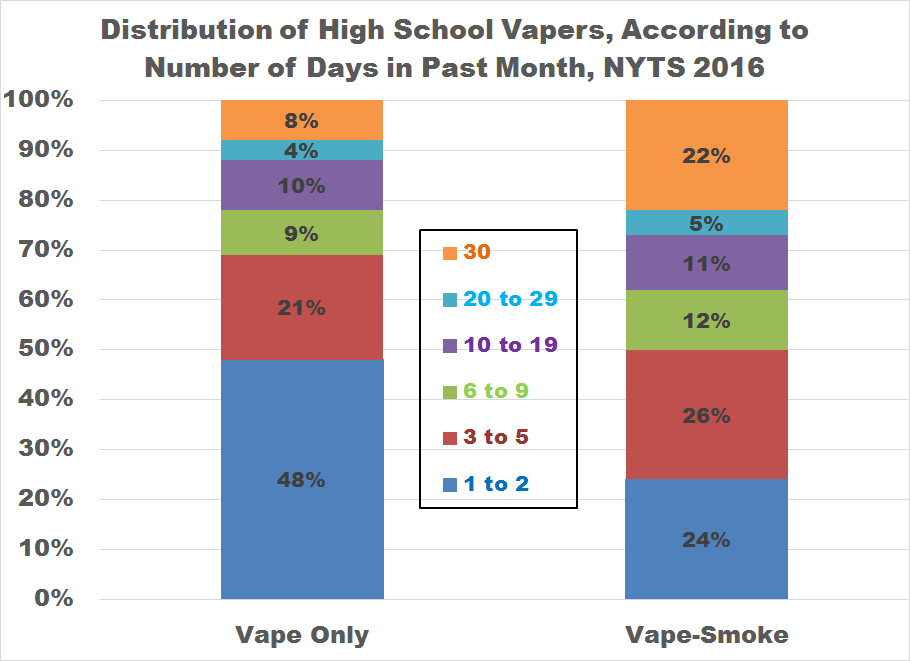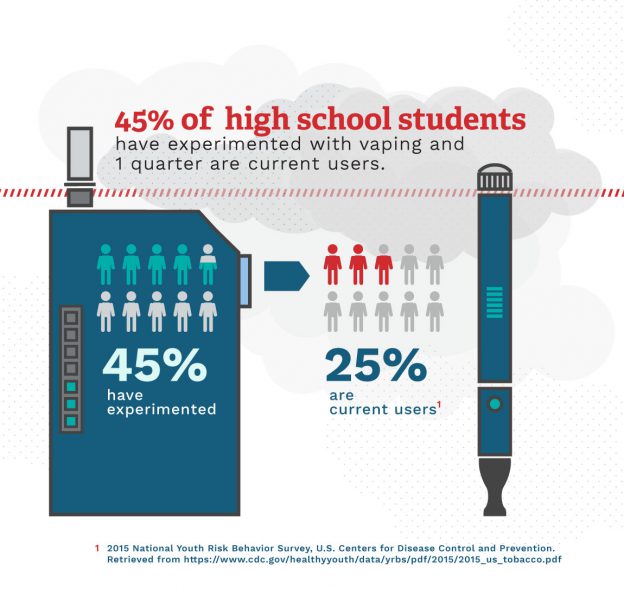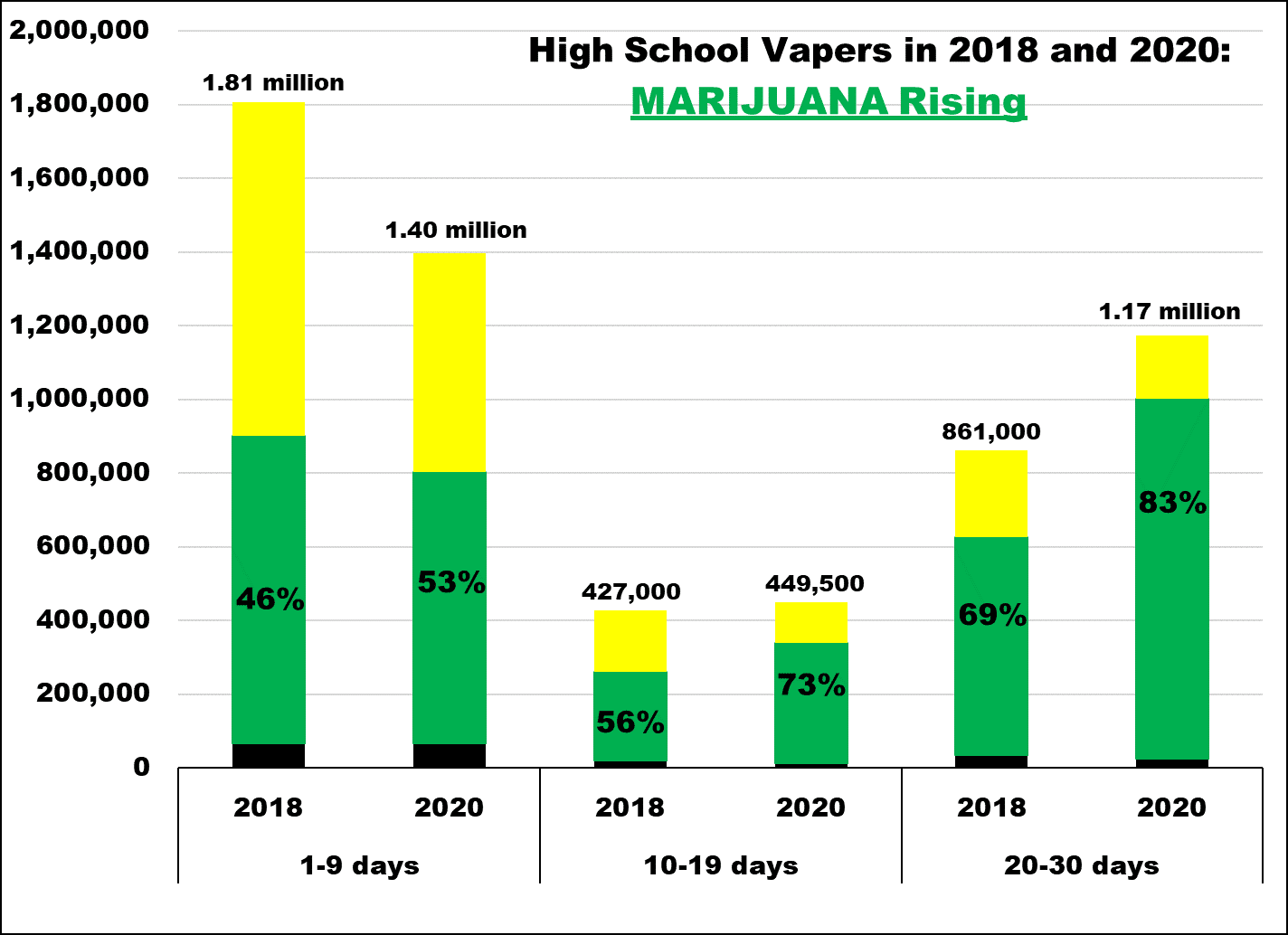
The study, published this month in the journal Nicotine & Tobacco Research, finds that over 80 percent of youth do not use any tobacco and over 86 percent don't vape—and among the minority who do vape, most are not regular users. In addition, the study reveals that most youth who are vaping are also current or former smokers.
Full Answer
What percentage of high school students vape?
Feb 17, 2022 · Among these, you would find 84.7% high school students, while middle schoolers made a number of 73.9%. In other words, 2.5 million and 0.4 million flavored vape smokers belonged to high school and middle school, respectively. Let’s hope the next vaping statistics will bring good news to the community. Popular Vaping Flavors Statistics 2022
How much harder is high school than middle school?
Sep 23, 2019 · Overall, the researchers found the percentage of youth who reported vaping a nicotine product in the past 30 days continued to climb across each of the grade levels examined. According to the researchers, 12th-graders had the highest 30-day use rates, with 25.4% of high school seniors reporting having vaped in the past 30 days in 2019, up from 20.9% in 2018.
What percentage of high school students smoke?
The preliminary data comes from the latest National Youth Tobacco Survey. About 3 million—or 20 percent—of high school students are vaping, according to the findings. In contrast, last year 1.73 million—or 11.7 percent—used e-cigarettes, according to recently published federal data.
How much homework do high schoolers get?

What percentage of high schoolers vape in 2021?
What percentage of high school students use electronic vaping devices?
What percent of high school students use nicotine?
What are the statistics on vaping?
Why is vaping a problem in schools?
How do teens deal with vaping?
- Reason with your child. Have an honest discussion about the effects of vaping and how this type of addiction can lead to other substance abuse. ...
- Be present. ...
- Talk, don't punish. ...
- Appeal to their desire for independence. ...
- Equip them with support and resources.
What happens if a 14 year old smokes?
Can a 17 year old smoke cigarettes?
Why do teens vape?
What ages vape the most?
How many deaths from vaping in the world?
...
| 2019–2020 vaping lung illness outbreak | |
|---|---|
| First outbreak | 2019 |
| First reported | April 2019 |
| Confirmed cases | 2,711 |
| Deaths | 61 |
What are the benefits of not vaping?
What percentage of young people do not vape?
Over 86 percent of young people do not vape—and among the minority who do, most are not regular users. Image: © Getty Images
How many people don't vape?
The study, published this month in the journal Nicotine & Tobacco Research, finds that over 80 percent of youth do not use any tobacco and over 86 percent don’t vape—and among the minority who do vape, most are not regular users.
Is vaping growing in 2019?
The analysis was conducted on the 2018 survey, the latest available full data set; the 2019 National Youth Tobacco Survey, which showed that youth vaping continued to grow from 2018 to 2019, has not yet been made available for public analysis.
Do e-cigarettes give nicotine?
While there has been fear that e-cigarettes are introducing nicotine to many young people who otherwise would not have smoked, the data show otherwise—only a small proportion of tobacco-naïve youth report vaping.
Is vaping safer than smoking?
While in a perfect world young people would not be smoking or vaping, if the vast majority of youth who vape are already current or former smokers, vaping could offer them a safer alternative than cancer-causing cigarettes,” said Ray Niaura, a professor of social and behavioral sciences at NYU School of Global Public Health and a study coauthor.
How many high school students use e-cigarettes in 2020?
In 2020, approximately one in five high school students and one in 20 middle school students currently used e-cigarettes. By comparison, in 2019, 27.5% of high school students (4.11 million) and 10.5% of middle school students (1.24 million) reported current e-cigarette use ( 2 ). Although these data reflect a decline in current e-cigarette use ...
How long has e-cigarette use been increasing?
E-cigarette use has increased considerably among U.S. youths since 2011 ( 1, 2 ). Multiple factors have contributed to this increase, including youth-appealing flavors and product innovations ( 1 – 3 ). Amid the widespread use of e-cigarettes and popularity of certain products among youths, on February 6, 2020, ...
How many people use e-cigarettes in 2020?
Although these data reflect a decline in current e-cigarette use since 2019, 3.6 million U.S. youths still currently used e-cigarettes in 2020, and among current users, more than eight in 10 reported using flavored e-cigarettes. Consistent with 2019, prefilled pods or cartridges were the most commonly used device type in 2020; however, ...
How can the FDA prevent youth tobacco use?
Comprehensive implementation of evidence-based strategies at the national, state, and local levels, in coordination with FDA regulation, can prevent and reduce youth tobacco product use ( 1, 4, 5 ). Strategies to address factors driving youth e-cigarette use are particularly critical. In addition to FDA’s enforcement policy that prohibits the sale of prefilled pod or cartridge-based e-cigarettes in any flavor other than tobacco or menthol, several states and communities have restricted all flavored e-cigarette sales, including menthol. §§
Is e-cigarette use dangerous?
The use of any tobacco product by youths is unsafe, including electronic cigarettes (e-cigarettes ) (1). Most e-cigarettes contain nicotine, which is highly addictive, can harm the developing adolescent brain, and can increase risk for future addiction to other drugs ( 1 ). E-cigarette use has increased considerably among U.S. youths since 2011 ( 1, 2 ). Multiple factors have contributed to this increase, including youth-appealing flavors and product innovations ( 1 – 3 ). Amid the widespread use of e-cigarettes and popularity of certain products among youths, on February 6, 2020, the Food and Drug Administration (FDA) implemented a policy prioritizing enforcement against the manufacture, distribution, and sale of certain unauthorized flavored prefilled pod or cartridge-based e-cigarettes (excluding tobacco or menthol).*
Is menthol used in e-cigarettes?
Although use of fruit flavored e-cigarettes was common among users in 2020, findings also suggest prominent menthol e-cigarette use, including among nearly one half of flavored prefilled pod or cartridge users and one quarter of flavored disposable product users.
How many high school students use cigars in 2020?
About 5 of every 100 high school students (5.0%) reported in 2020 that they had used cigars in the past 30 days—a decrease from 11.6% in 2011.
How many middle schoolers smoke in 2020?
Nearly 2 of every 100 middle school students (1.6%) reported in 2020 that they smoked cigarettes in the past 30 days—a decrease from 4.3% in 2011.
What is a heat not burn product?
Heated tobacco products, also known as “heat-not-burn” products, deliver nicotine to the user by heating tobacco leaves rather than a nicotine-containing liquid like e-cigarettes do.
Why are youth more likely to use tobacco products?
Youth are more likely to use tobacco products if they see people their age using these products. Young people may be more likely to use tobacco products if a parent uses these products. There is evidence that youth may be sensitive to nicotine and that teens can feel dependent on nicotine sooner than adults.
What are the factors that make quitting smoking harder for young people?
There is evidence that youth may be sensitive to nicotine and that teens can feel dependent on nicotine sooner than adults. Genetic factors may make quitting smoking harder for young people.
Why is it so hard to quit smoking?
Genetic factors may make quitting smoking harder for young people. Smoking during pregnancy may increase the likelihood that the child will smoke cigarettes regularly in the future. Mental health: There is a strong relationship between youth smoking and depression, anxiety, and stress. 2.
What are the influences of smoking in youth?
2,12. Other influences that affect youth tobacco use include: 2,12 , Lower socioeconomic status, including lower income or education.
What percentage of students vape daily?
The researchers found the percentage of students who reported vaping daily was 11.7% among 12th graders, 6.9% among 10th graders, and 1.9% among 8th graders. The researchers wrote that those rates are alarming, as the frequency of use suggests teens may have developed a nicotine addiction.
Is vaping slowing down?
The authors noted that nicotine vaping rates have been climbing since 2017, and the current data suggest they are not slowing down.
How many 12th graders are using vaping?
With the recent Monitoring the Future Study release indicating that nearly one in three 12th graders reported using a vaping device in the past year, it’s imperative that parents are informed of the potential dangers that can result from vaping.
Why do teens vape?
More than half of teens who vape say they do it because they like the flavors that e-cigarette liquids come in, and say vaping is fun. More than two-thirds said they think vaping can be part of a “healthy life.”
Is vaping a part of life?
More than two-thirds said they think vaping can be part of a “healthy life.”. Earlier this month, Food and Drug Administration Commissioner Scott Gottlieb said youth e-cigarette use in the United States is an epidemic, and announced new steps his agency is taking to prevent youth vaping.
